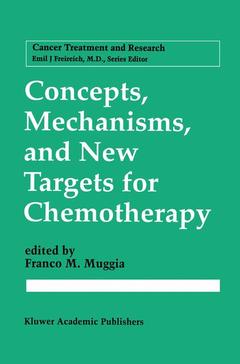Description
Concepts, Mechanisms, and New Targets for Chemotherapy, 1995
Cancer Treatment and Research Series, Vol. 78
Coordinator: Muggia Franco M.
Language: English
Subjects for Concepts, Mechanisms, and New Targets for Chemotherapy:
Keywords
DNA; breast cancer; cancer; carcinoma; chemotherapy; clinical trial; diseases; neoplasm; prostate cancer; systemic therapy; therapy; tumor
Publication date: 12-2012
237 p. · 15.5x23.5 cm · Paperback
237 p. · 15.5x23.5 cm · Paperback
Description
/li>Contents
/li>
Concepts, Mechanisms, and New Targets for Chemotherapy describes new interconnections between rationally designed and empirically discovered compounds. One route that has not been travelled previously is that of protein kinase C inhibition. This pathway may be exploited to give potent inhibitors, such as the bryostatins, now in clinical trial. A summary is given of the current status of topoisomerase, focusing on recent clinical advances with camptothecin analogs based on connecting empiricism with concepts of drug selectivity.
Modification of existing therapies based on the pursuit of leads arising from mechanistic studies is also being applied clinically on a wide scale. Greater understanding should follow from the studies of reversal of the multidrug resistant phenotype, on the use of hydroxyurea to reverse resistance mediated by extrachromosomal DNA, and on various aspects of the fluoropyrimidine pathways.
Successful applications of chemotherapy to the treatment of specific diseases include the growing applications of systemic therapy using various skin malignancies. In prostate cancer, estramustine phosphate will likely play an expanding role. Taxanes are restructuring treatment regimens in breast cancer, and high-dose strategies are described with peripheral blood progenitor autografting in the treatment of ovarian and breast cancers.
Modification of existing therapies based on the pursuit of leads arising from mechanistic studies is also being applied clinically on a wide scale. Greater understanding should follow from the studies of reversal of the multidrug resistant phenotype, on the use of hydroxyurea to reverse resistance mediated by extrachromosomal DNA, and on various aspects of the fluoropyrimidine pathways.
Successful applications of chemotherapy to the treatment of specific diseases include the growing applications of systemic therapy using various skin malignancies. In prostate cancer, estramustine phosphate will likely play an expanding role. Taxanes are restructuring treatment regimens in breast cancer, and high-dose strategies are described with peripheral blood progenitor autografting in the treatment of ovarian and breast cancers.
1. Potential for protein kinase C inhibitors in cancer therapy.- 2. Recent clinical advances with camptothecin analogues.- 3. The reversal of multidrug resistance.- 4. Fluoropyrimidine catabolism.- 5. Use of hydroxyurea to alter drug resistance of human tumor cells.- 6. Aspects of one-carbon folate cycling related to fluoropyrimidine and antifolate therapy.- 7. Systemic therapy of skin carcinoma.- 8. Estramustine revisited.- 9. Taxoid compounds in breast cancer: Current status and future prospects.- 10. High-dose chemotherapy with peripheral blood progenitor autografting.
© 2024 LAVOISIER S.A.S.
These books may interest you

Multi-Drug Resistance in Cancer 158.24 €

Therapeutic Kinase Inhibitors 158.24 €


